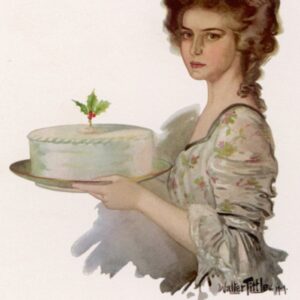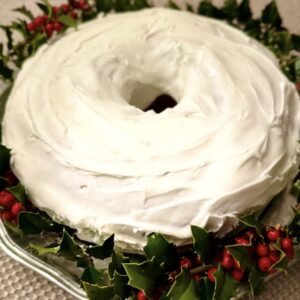 Commemorating the Feast of Epiphany on January 6th, Twelfth Night signifies the conclusion of the Twelve Days of Christmas. Twelfth Night Cake symbolizes the search for the baby Jesus by the Three Wise Men: a delightful confection steeped in tradition, holds roots that traverse medieval Europe, embraced by both English and American cultures with their distinct nuances.
Commemorating the Feast of Epiphany on January 6th, Twelfth Night signifies the conclusion of the Twelve Days of Christmas. Twelfth Night Cake symbolizes the search for the baby Jesus by the Three Wise Men: a delightful confection steeped in tradition, holds roots that traverse medieval Europe, embraced by both English and American cultures with their distinct nuances.
Originally a fruit cake, it has also evolved into an almondy, buttery sponge or pastry based treat. A central element involves concealing a token or bean within the cake, conferring the title of “King” or “Queen” upon the finder for the day.
In England, the Twelfth Night Cake boasts a heritage deeply embedded in its historical tapestry. Here, the cake exudes a more traditional essence, maintaining its ties to ancient customs and rituals. The baking process emphasizes a blend of classic ingredients—spices like cinnamon, nutmeg, and cloves mingle with dried fruits and spirits, encapsulating centuries-old flavors. The cake’s adornments often echo a sense of nostalgia, featuring elegant designs and symbols reflecting English heritage.
While evolving over time, the English Twelfth Night Cake retains a profound connection to its cultural heritage, preserving the essence of celebration and tradition cherished through generations.
In contrast, the American rendition of the Twelfth Night Cake underwent an evolution, particularly during the Gilded Age—a period of opulence and prosperity. The American elite of this era transformed the cake into an extravagant culinary spectacle. The emphasis shifted towards luxurious ingredients sourced globally, incorporating exotic spices, rare fruits, and premium liquors. Elaborate decorations became a hallmark of these American Twelfth Night Cakes, showcasing intricate sugar sculptures, marzipan figurines, and gilded accents. This version of the cake mirrored the era’s penchant for grandeur, becoming a symbol of affluence and sophistication at the lavish gatherings of the elite.
Despite their divergent paths, both the English and American traditions of the Twelfth Night Cake uphold the spirit of celebration and communal joy. The English version cherishes its historical roots, fostering a connection to ancient customs and flavors, while the American adaptation epitomizes the Gilded Age’s opulence, serving as a testament to excess and luxury. Yet, at their core, both versions embody the essence of the festive season, uniting people in revelry and tradition, albeit in their distinct and charming ways.
During the Gilded Age, it was customary to bake Twelfth Night Cake in a ring-shaped mold. Once it was iced, red and white candles were often placed on the top to form a five-pointed star shape and sprigs of fresh holly were added as a garnish, creating a wreath-like appearance.
Twelfth Night Cake
Ingredients
- 3 1/2 cups cake flour
- 3 tsp. baking powder
- 1/2 tsp. salt
- 1 cup butter unsalted, softened
- 2 cups sugar
- 5 large egg yolks separated individually (reserve egg whites)
- 1/2 cup orange juice
- 1/2 cup milk
- 3 large egg whites
- 1 dried bean 1 dried black-eye pea, and 1 clove
- Red and white candles and fresh holly for garnish (optional)
Instructions
- Preheat oven to 350°F. Grease and flour a 10-inch tube pan and set aside. Sift flour, baking powder, and salt in a large bowl.
- In a separate bowl, cream butter using an electric mixer on medium-high speed until smooth. Gradually add the sugar, beating until light and fluffy, scraping down the sides of the bowl if necessary. Add the egg yolks one at a time, beating after each addition. Turn mixer speed to low and add flour alternately with orange juice and milk.
- In a separate glass or stainless steel bowl, beat egg whites on low speed until foamy, about 3–4 minutes, then increase speed to medium and continue to beat another 5–8 minutes or until stiff. Fold into the batter (best done by hand).
- Transfer the batter to the tube pan and bake for 1 hour or until a toothpick inserted into the center comes out clean. Cool for 10 minutes on a wire rack, then place another rack on top and carefully flip the cake. It should slide out of the pan onto the rack.
- Remove the bottom of the tube pan. Insert the bean, pea, and clove into different parts of the cake. Allow it to cool completely before frosting with royal icing.


